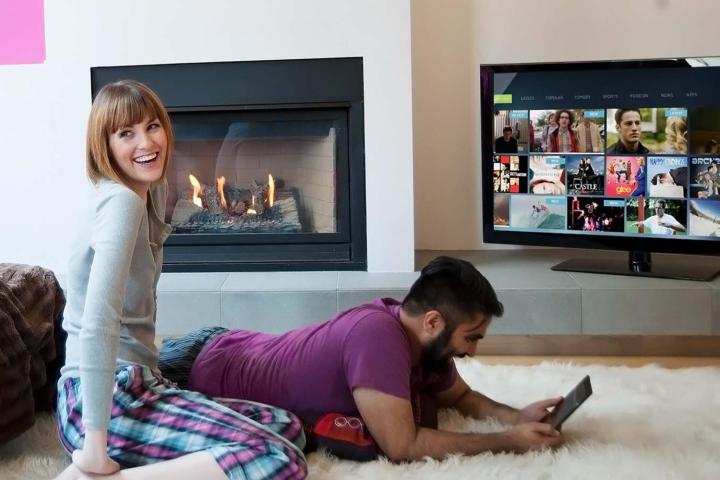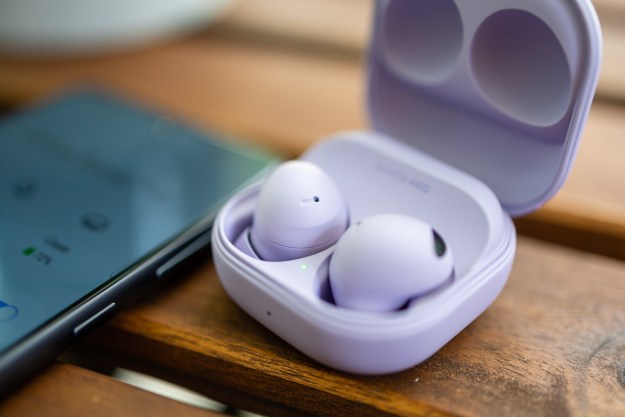
Some think of it as multiple shows streaming on different devices in the same room, or someone tweeting about their favorite show on a smartphone while (sort of) watching it on a tablet. Sure, these could be considered examples of multi-screen viewing, but they’re really just flirting with the possibilities. In the near future, your smart TV is going to tell your mobile device what to show you, and when to show it. It will adapt based on your viewing habits and preferences, and make that second screen more of an add-in than an add-on to your daily TV-watching. Forget 4K and OLED, this is what the future of TV is going to look like.
Right now, most “second-screen” usage is more distracting than it is enriching, but that’s about to change. Soon your tablet will spring to life when you tune into your favorite show, and you’ll have more opportunities than ever to engage. The million-dollar buzzword here is Automatic Content Recognition, or ACR. But, before we get too far into that, let’s start at the beginning: the screen itself.
Right now, most “second-screen” usage is more distracting than it is enriching, but that’s about to change.
We apparently like screens so much, research also shows that we don’t just stick to one screen anymore. More than a third of adults specifically look for devices they can connect to their existing devices across their home network. “Media multi-tasking” is commonplace — what hasn’t caught up yet is the technology, at least in the affordable mainstream. Even though many of our everyday gadgets are “smart,” they don’t necessarily speak the same language as other smart devices. As a result, many companies are trying to make different devices play nicely with each other, to create a more seamless, cohesive experience.
One such company is San Francisco-based Samba TV, originally founded as Flingo in 2008. Samba TV is baking its “second-screen” apps and software directly into smart TVs, most recently with Sony. Samba CEO Ashwin Navin, the co-founder and former president of BitTorrent, Inc., says Samba TV is essentially leveraging the technologies that are already in American households today to get more out of the TV. Specifically, Navin wants the TV experience to become a more robust, multi-screen experience.

Originally, Flingo enabled users to “fling” video content from a smartphone to TV, much like Google’s Chromecast. Navin says the company eventually decided to reverse the pathway, instead moving in the opposite direction: from television to smartphone (or tablet, or computer). Navin says this was the reason the company decided to rebrand as Samba TV in September 2013.
Just two months later in November, the company released a line of apps that are now featured in a number of connected Sony devices, like Blu-ray players and Bravia TVs. The apps recognize what is playing on a connected smart TV, then direct related content, like info about the actors on the screen, straight to smartphones and tablets. One is Samba’s own proprietary app, Launchpad, which offers content from A&E, FOX, Fitness Magazine, Vimeo, College Humor and more.
Navin, like many of his colleagues in the industry, believes the television experience today to be broken. People may be multi-tasking while they watch television now more than ever, but Navin says, “that’s not because they’re using a specific app that helps them find more shows. They’re doing a variety of things like Facebook, Twitter, Email, Angry Birds, Flappy Birds, whatever. And that’s capturing some of their attention. The experience is pretty broken in that it’s still today very difficult to find things that interest you.”
More than a third of adults specifically look for devices they can connect to their existing devices across their home network.
Basically, even though many of us have access to thousands of channels, our media multi-tasking is more often than not a mash-up of different things, rather than a handful of content that complements what’s on the big screen. This is what Navin sees as “a huge amount of value trapped in the television for the consumer and for the advertisers that we want to make available on mobile devices.”
Advertisers? Oh yes, there’s money to shake out of that little screen in your pocket, too. But Navin says that doesn’t have to be detrimental. Samba TV, he says, wants to create an ecosystem where advertisers, broadcasters, TV manufacturers, cable operators and app developers – all symbiotically dependent on one another – create an experience that actually holds the user’s attention. Though this kind of new technology is often a hard sell to old world-minded advertisers, Navin says his company’s model is beneficial to all parties. He believes advertisers can potentially receive “a better return on investment with ads that manifest through to the multi-screen ad experience that starts with a 30-second commercial — the traditional TV ad — but expands into a digital companion experience that might be on a phone, tablet or PC.”
Say a movie studio is promoting a new movie. Naturally, it creates a trailer and throws it into various markets throughout the country with a certain expected return on investment. Normally, someone watching TV when that trailer appears is either interested in the film or not. If they are, they might pull out their smartphone or open their laptop and Google-search the film title. If the movie is out, they might look at local show times, read reviews, check out Rotten Tomatoes.

For a user with a Samba-supported smart TV, this process is made effortless. Samba’s apps allow the TV to recognize the trailer and immediately push all related content to the user’s smartphone or tablet. Without doing a thing, the user is already looking at local show times, ticket prices, reviews, alternate trailers, and much more. Navin says that advertisers look at this as a “retargeting experience,” one that might allow the studio behind the movie to get a better return on investment from their commercial.
But for now, the pathway is still pretty disjointed because of our current home theater ecosystem’s mixed implementation of smart, semi-smart and downright dumb devices.
Navin sees all of this as natural and part of a process; he doesn’t think that any one link in the TV chain deserves the blame for our current state of affairs. “I think it’s just that there’s a lot of antiquated systems out there that haven’t really changed in a long time, and they’re very expensive to operate and upgrade … so that’s the reason we have this brokenness. The good news is that there’s smarter and smarter devices showing up in people’s houses … including smart TVs.”
For now, our home entertainment systems remain a hodgepodge of the old, the current, and the new. But, as smart devices in the home evolve and get better at understanding the things consumers actually care about, broadcasters will have new ways of getting their content discovered that aren’t so overwhelmingly dependent on their legacy distributors, and advertisers will have a whole new playground to play in. When that happens, the way we consume television will never be the same.
Editors' Recommendations
- Amazon is trying to prove that AirPlay and Chromecast don’t matter
- Don’t bother sending back those final Netflix DVD rentals


